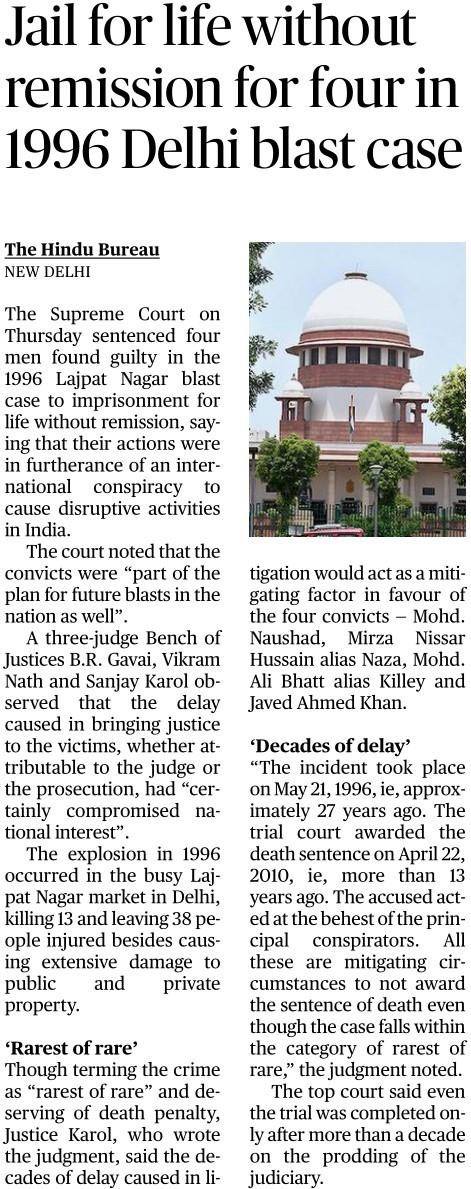The G-20 summit in India is one of the “most important” events for Moscow Russian President Vladimir Putin could attend the summit, which would be the first time he would come face to face with Western leaders since the war in Ukraine began.
In 2022, Mr. Putin skipped the G-20 summit in Bali, given the war in Ukraine and threats from Western leaders to boycott him.
Russia was “determined to support the Indian presidency to ensure the success of the G-20 Summit”, the diplomat did not hold out hope that Russia and China would agree to the draft statement — which could result in a failure to issue a joint communique, a first in the G-20 grouping’s history.
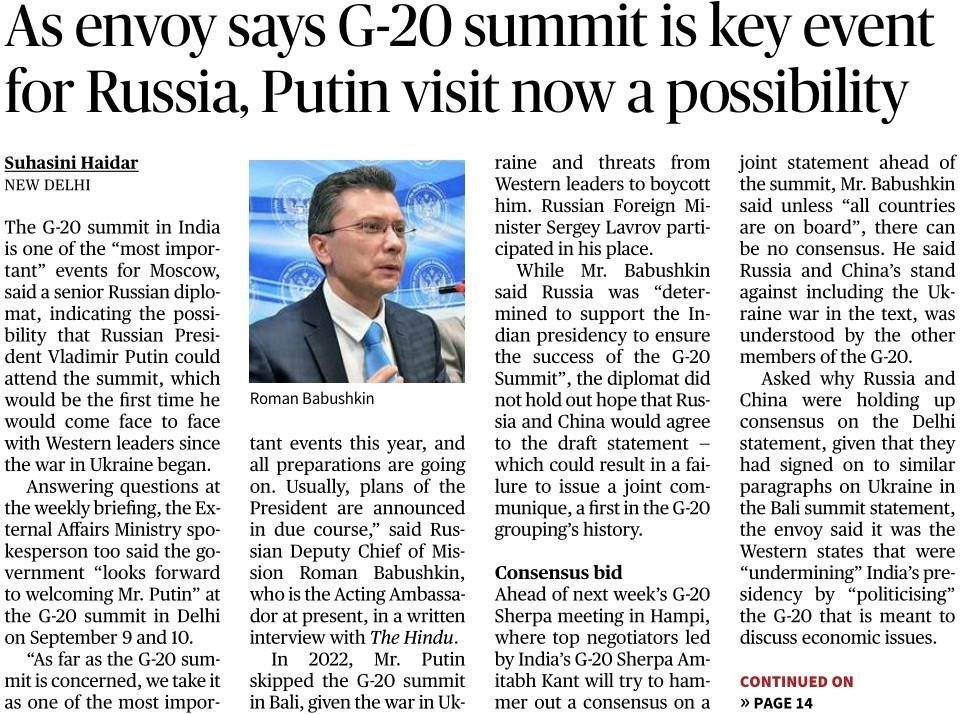
Consensus bid
Asked why Russia and China were holding up consensus on the Delhi statement, given that they had signed on to similar paragraphs on Ukraine in the Bali summit statement, the envoy said it was the Western states that were“undermining” India’s presidency by “politicising” the G-20 that is meant to discuss economic issues.
“The Western choice for upscaling geopolitical tensions makes the so-called ‘Bali consensus’, which was a huge compromise from the Russian side last year, even more irrelevant,”
“Global power pursuing diversified foreign policy according to its national interests”, India’s partnership with the U.S. is natural, and Russia would not comment on another bilateral relationship. “Unfortunately, the U.S. is preoccupied with this very purpose to get Russia out of India, weaken our cooperation and involve India in its geopolitical games,”
“Whatever the U.S. is offering to India in the defence area, it cannot match the level and depth of the Russian-Indian cooperation,”
Asked if delays in the S-400 Triumf missile system deliveries to India indicated India-Russia defence ties would be affected by the Ukraine war.
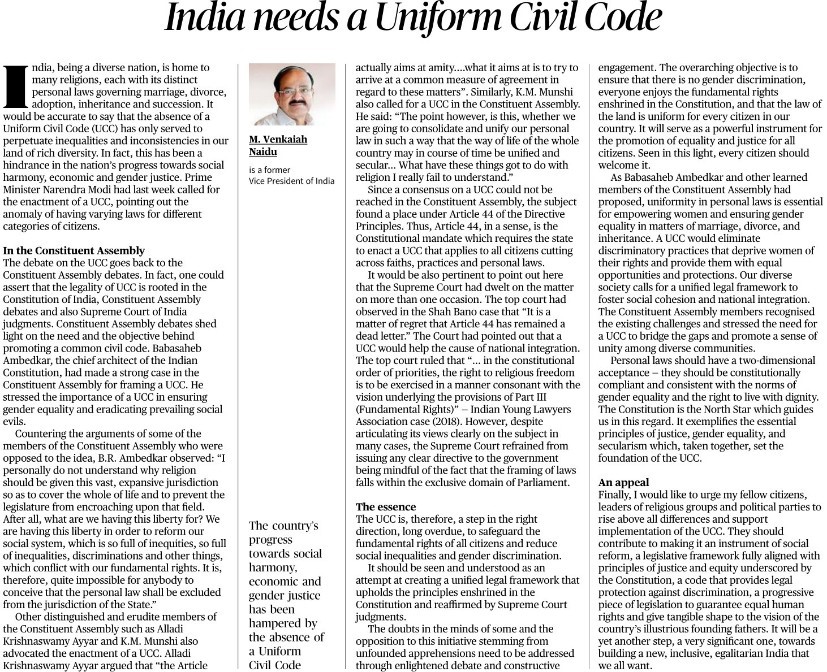
India, being a diverse nation, is home to many religions, each with its distinct personal laws governing marriage, divorce, adoption, inheritance and succession. It would be accurate to say that the absence of a Uniform Civil Code (UCC) has only served to perpetuate inequalities and inconsistencies in our land of rich diversity.
In fact, this has been a hindrance in the nation’s progress towards social harmony, economic and gender justice.
In the Constituent Assembly
The debate on the UCC goes back to the Constituent Assembly debates. In fact, one could assert that the legality of UCC is rooted in the Constitution of India, Constituent Assembly debates and also Supreme Court of India judgments.Constituent Assembly debates shed light on the need and the objective behind promoting a common civil code.
Babasaheb Ambedkar, the chief architect of the Indian Constitution, had made a strong case in the Constituent Assembly for framing a UCC. He stressed the importance of a UCC in ensuring gender equality and eradicating prevailing social evils.
Countering the arguments of some of the members of the Constituent Assembly who were opposed to the idea, B.R. Ambedkar observed: “I personally do not understand why religion should be given this vast, expansive jurisdiction so as to cover the whole of life and to prevent the legislature from encroaching upon that field. After all, what are we having this liberty for? We are having this liberty in order to reform our social system, which is so full of inequities, so full of inequalities, discriminations and other things, which conflict with our fundamental rights. It is, therefore, quite impossible for anybody to conceive that the personal law shall be excluded from the jurisdiction of the State.”
Since a consensus on a UCC could not be reached in the Constituent Assembly, the subject found a place under Article 44 of the Directive Principles. Thus, Article 44, in a sense, is the Constitutional mandate which requires the state to enact a UCC that applies to all citizens cutting across faiths, practices and personal laws.
The essence
The UCC is, therefore, a step in the right direction, long overdue, to safeguard the fundamental rights of all citizens and reduce social inequalities and gender discrimination.
It should be seen and understood as an attempt at creating a unified legal framework that upholds the principles enshrined in the Constitution and reaffirmed by Supreme Court judgments.

Food inflation threatens to undermine efforts to ensure price stability
The latest Purchasing Managers’ Index (PMI) for India’s manufacturing sector and the Services Business Activity Index for the economy’s broader services sector from S&P Global, posit a softening in momentum in economic activity.
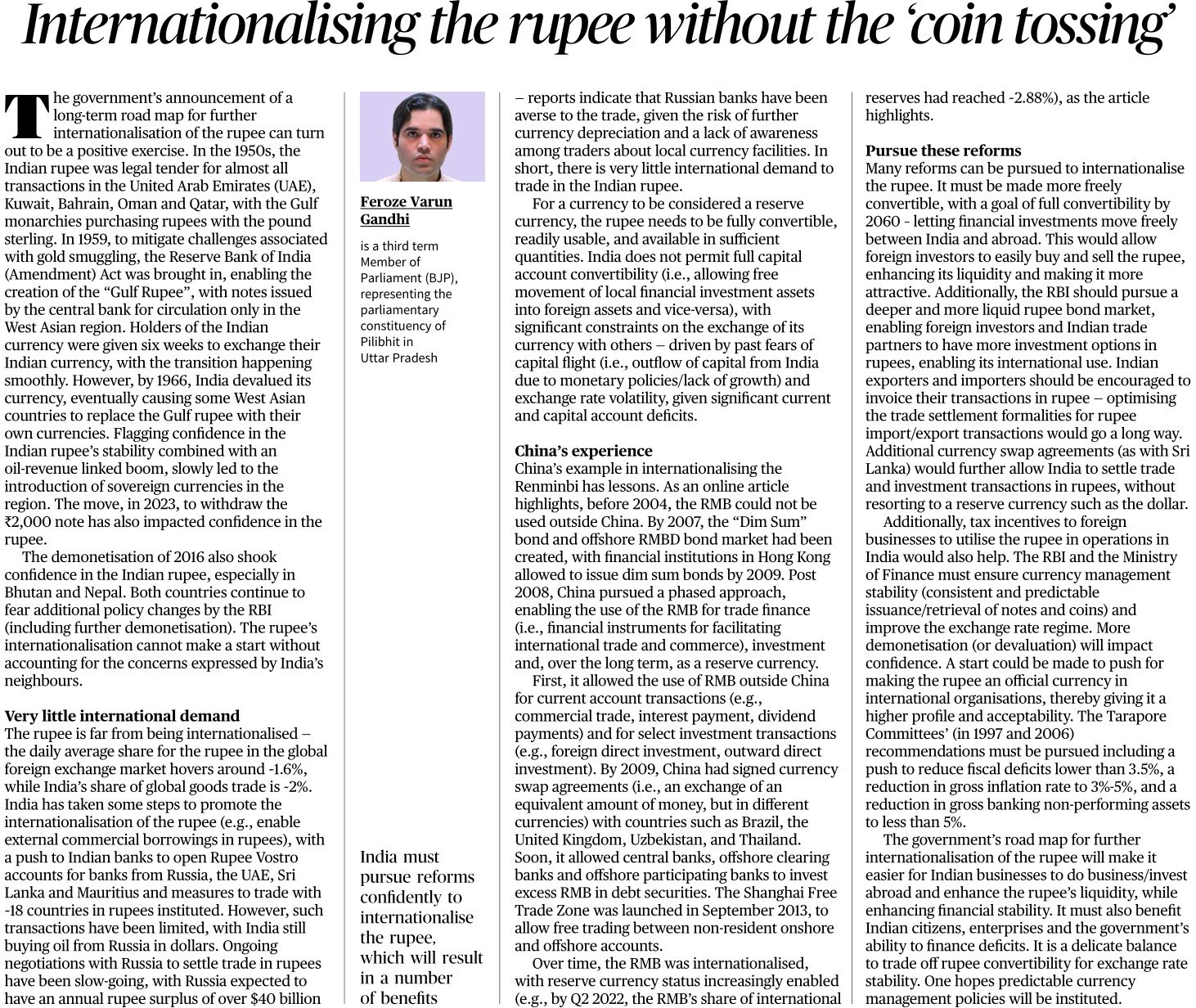
The government’s announcement of a long-term road map for further internationalisation of the rupee can turn out to be a positive exercise. In the 1950s, the Indian rupee was legal tender for almost all transactions in the United Arab Emirates (UAE), Kuwait, Bahrain, Oman and Qatar, with the Gulf monarchies purchasing rupees with the pound sterling.
In 1959, to mitigate challenges associated with gold smuggling, the Reserve Bank of India (Amendment) Act was brought in, enabling the creation of the “Gulf Rupee”, with notes issued by the central bank for circulation only in the West Asian region.
However, by 1966, India devalued its currency, eventually causing some West Asian countries to replace the Gulf rupee with their own currencies. Flagging confidence in the Indian rupee’s stability combined with an oil-revenue linked boom, slowly led to the introduction of sovereign currencies in the region.
The move, in 2023, to withdraw the ₹2,000 note has also impacted confidence in the rupee.
The demonetisation of 2016 also shook confidence in the Indian rupee, especially in Bhutan and Nepal.
Very little international demand
The rupee is far from being internationalised — the daily average share for the rupee in the global foreign exchange market hovers around ~1.6%, while India’s share of global goods trade is ~2%.
India has taken some steps to promote the internationalisation of the rupee (e.g., enable external commercial borrowings in rupees), with a push to Indian banks to open Rupee Vostro accounts for banks from Russia, the UAE, Sri Lanka and Mauritius and measures to trade with ~18 countries in rupees instituted.
However, such transactions have been limited, with India still buying oil from Russia in dollars.
China’s experience
China’s example in internationalising the Renminbi has lessons. As an online article highlights, before 2004, the RMB could not be used outside China.
First, it allowed the use of RMB outside China for current account transactions (e.g., commercial trade, interest payment, dividend payments) and for select investment transactions (e.g., foreign direct investment, outward direct investment).
By 2009, China had signed currency swap agreements (i.e., an exchange of an equivalent amount of money, but in different currencies) with countries such as Brazil, the United Kingdom, Uzbekistan, and Thailand.
Pursue these reforms
The government’s road map for further internationalisation of the rupee will make it easier for Indian businesses to do business/invest abroad and enhance the rupee’s liquidity, while enhancing financial stability.
It must also benefit Indian citizens, enterprises and the government’s ability to finance deficits. It is a delicate balance to trade off rupee convertibility for
exchange rate stability. One hopes predictable currency management policies will be instituted.

Important points:
- Indus Water Treaty
- Hydro Power Project in Kashmir
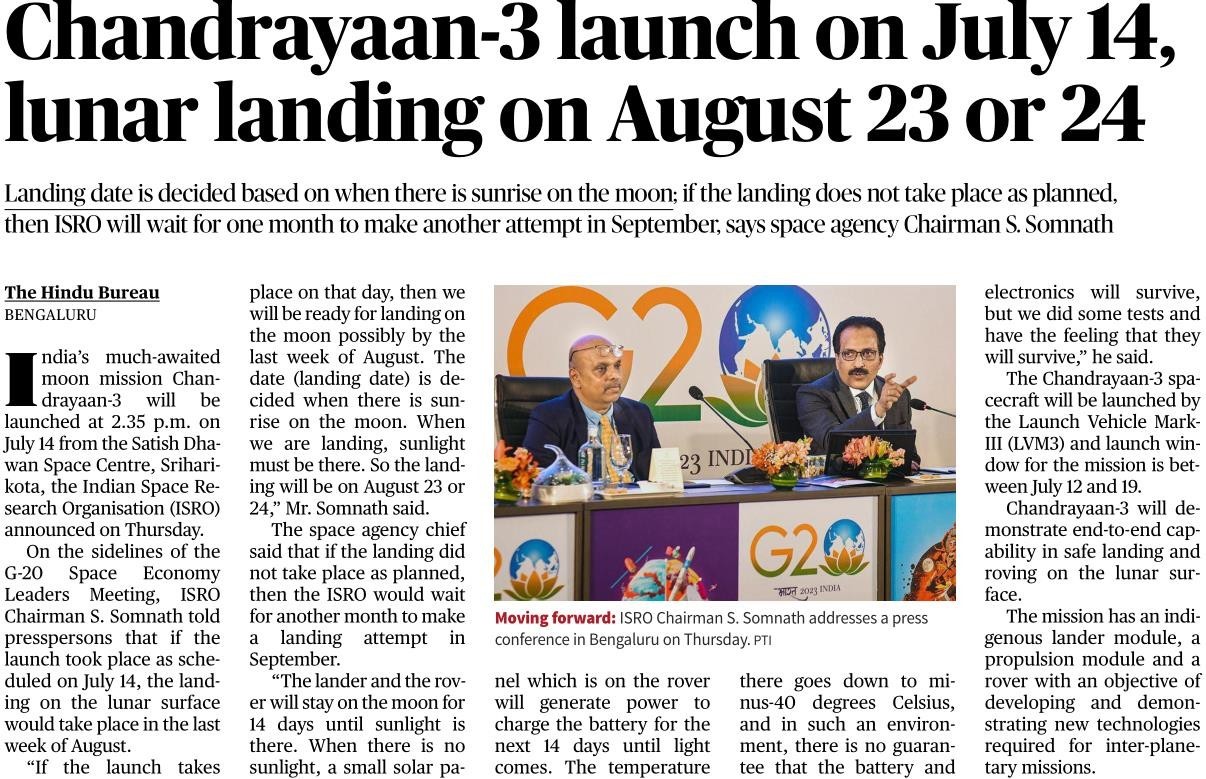
India’s much-awaited moon mission Chandrayaan-3.
The space agency chief said that if the landing did not take place as planned, then the ISRO would wait for another month to make a landing attempt in September. The Chandrayaan-3 spacecraft will be launched by the Launch Vehicle Mark- III (LVM3) and launch window for the mission is between July 12 and 19.
India’s exports are likely to be hit by the European Union’s 20% to 35% tariffs on high-carbon goods like steel, iron ore and cement, the finance ministry
In April, the EU approved the world’s first plan to impose a levy on high-carbon goods imports from 2026, aiming to become a net zero emitter of greenhouse gases by 2050, some 20 years earlier than India’s target.
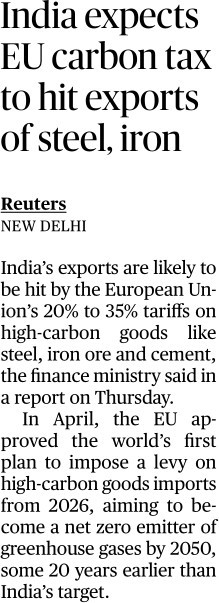
The Supreme Court on Thursday sentenced four men found guilty in the 1996 Lajpat Nagar blast case to imprisonment for life without remission, saying that their actions were in furtherance of an international conspiracy to cause disruptive activities in India.
‘Rarest of rare’
Though terming the crime as “rarest of rare” and deserving of death penalty, the decades of delay caused in litigation would act as a mitigating factor in favour of the four convicts.
‘Decades of delay’
“The incident took place on May 21, 1996, ie, approximately 27 years ago. The trial court awarded the death sentence on April 22, 2010, ie, more than 13 years ago. The accused acted at the behest of the principal conspirators. All these are mitigating circumstances to not award the sentence of death even though the case falls within the category of rarest of rare,”
The top court said even the trial was completed only after more than a decade on the prodding of the judiciary.
